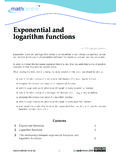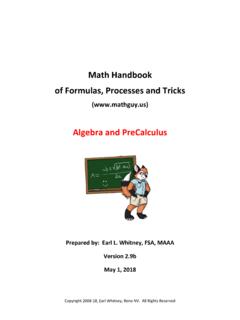Transcription of Why certain integrals are ``impossible'.
1 IntroductionElementary functions and fieldsLiouville s TheoremAn exampleWhy certain integrals are impossible .Pete GoetzDepartment of MathematicsSonoma State UniversityMarch 11, 2009 IntroductionElementary functions and fieldsLiouville s TheoremAn fields and s functions and fieldsLiouville s TheoremAn exampleProbabilityCentral Limit Theorem (x)=1 2 x e u2/2duFor probability applications, we need ( ) = is not proved by finding a formula for (x) (by findingan explicit antiderivative ofe u2/2) and taking the limit asx .IntroductionElementary functions and fieldsLiouville s TheoremAn exampleNumber TheoryPrime Number Theorem (x) = #{n x|nis prime}Li(x)= x21ln(t)dt (x) Li(x) asx This is not proved by finding an explicit antiderivative of1ln(t).
2 Ifu= ln(t), then 1ln(t)dt= functions and fieldsLiouville s TheoremAn exampleElementary formulasThe indefinite integrals e u2duand euududo not haveelementary does one prove such claims?First have to give a precise definition of elementary formula .After all e u2du= uae x2dx+Cfor any constantsaandCby functions and fieldsLiouville s TheoremAn exampleHistoryNewton was perfectly happy to solve an integral by a preferred integration in finite terms and allowedtranscendental functions like functions and fieldsLiouville s TheoremAn exampleElementary functionAnelementary function(roughly)
3 Should be a function ofone variable built out of polynomials, exponentials,logarithms, trigonometric functions , and inverse trigonometricfunctions, by using the operations of addition, multiplication,division, root extraction, and :sin 1(x3 1) lnx+ cos(x/x2+ 1)IntroductionElementary functions and fieldsLiouville s TheoremAn exampleA simplificationWe will useC-valued functions of therealvariablex, , ourconstants will be complex trigonometric functions and inverse-trigonometricfunctions can be written in terms of complex exponentials (x)=eix e ix2i, cos(x)=eix+e ix2tan 1(x)=12i(ln(x ix+i) i )sin 1(x) = tan 1(x 1 x2), cos 1(x) = tan 1( 1 x2x)
4 IntroductionElementary functions and fieldsLiouville s TheoremAn exampleMeromorphic functionsAmeromorphic functionis a function defined on an openintervalIof the real numbers whose values are complexnumbers or with the property that sufficiently close to anyx0inIthe function is given by a convergent Laurent series inx functions are meromorphic a meromorphic functionf, bothefand lnfaremeromorphic (one may have to restrict the domain off).IntroductionElementary functions and fieldsLiouville s TheoremAn exampleFields of meromorphic functionsLetC(x) denote the field of rational functions .
5 Notice thatthis field is closed under elementary function (under our rough definition) shouldbe in some extension ofC(x).IntroductionElementary functions and fieldsLiouville s TheoremAn exampleFields of meromorphic functionsIff1,..,fnare meromorphic functions , letC(f1,..,fn)denote the set of all meromorphic functionshof the formh=p(f1,..,fn)q(f1,..,fn)for somen-variable polynomialsp,q'= 0 andq(f1,..,fn) isnot identically definition captures the operations of addition,multiplication, and is not hard to show that the setC(f1,..,fn) is a field andthat this field is closed under :K=C(x,sinx,cosx)=C(x,eix).
6 IntroductionElementary functions and fieldsLiouville s TheoremAn exampleElementary fieldsA fieldKis anelementary fieldifK=C(x,f1,..,fn) andeachfjisan exponential or logarithm of an element ofKj 1=C(x,f1,..,fj 1)orfjisalgebraicoverKj 1, that isfjis a solution to anequationgltl+ +g1t+g0= 0 whereg0,g1,..,gl Kj 1An elementary field is built from the the field of rationalfunctions in finitely many steps by adjoining an exponential , alogarithm, or a solution to a is captured by adjoining exponentials orlogarithms. Root extraction is captured by the adjunction ofalgebraic fields are closed under functions and fieldsLiouville s TheoremAn exampleElementary functionsA meromorphic functionfis anelementary functionif it liesin some elementary.
7 F(x)=3 lnx+ cos(xx2+i) is an elementaryfunctionC(x) C(x,lnx) C(x,lnx,ei(xx2+i)) C(x,lnx,ei(xx2+i),f)IntroductionElementa ry functions and fieldsLiouville s TheoremAn exampleElementary integrationA meromorphic functionfcan beintegrated in elementarytermsiff=g for some elementary an elementary field is closed under differentiation so iffcan be integrated in elementary terms, then necessarilyfisalso functions and fieldsLiouville s TheoremAn exampleDifferential Galois theoryWe can rephrase our problem: Given an elementary functionf, when does the differential equationdydx f= 0 have anelementary solution?
8 The answer is in the affirmative precisely when we can find atower of fields with special the analogy with ordinary Galois functions and fieldsLiouville s TheoremAn exampleLiouville s ThereomTheorem (Liouville, 1835):Letfbe an elementary functionand letKbe any elementary field containingf. Iffcan beintegrated in elementary terms then there exist nonzeroc1,..,cn C, nonzerog1,..,gn K, and an elementh Ksuch thatf= cjg jgj+h .Iff= cjg jgj+h , theng= cjln(gj)+his an elementaryantiderivative theorem is proved by induction on the length of a towerof fields constructingK(g) wheregis an antiderivative functions and fieldsLiouville s TheoremAn exampleAn important corollaryCorollary:Letfandgbe inC(x) withf'= 0 andgnonconstant.
9 Iff(x)eg(x)can be integrated in elementaryterms then there is a functionR(x) inC(x) such thatR (x)+g (x)R(x)=f(x).IfR(x) C(x) satisfiesR (x)+g (x)R(x)=f(x), thenR(x)eg(x) is an antiderivative off(x)eg(x).We can apply this corollary to show thate x2andex/xhaveno elementary functions and fieldsLiouville s TheoremAn exampleProof fore x2 Takingf= 1 andg= x2in the Corollary, we must show thedifferential equationR (x) 2xR(x) = 1 ( )has no solution forR(x) C(x).ODE s shows the general solution of ( ) isR(x)=ex2( e x2dx+c) for anyc but this doesn thelp!
10 IntroductionElementary functions and fieldsLiouville s TheoremAn exampleProof fore x2 Suppose thatR(x) C(x) is a solution to ( ).Rcannot be a constant or a polynomial inx(by degreeconsiderations).WriteR(x)=p(x)q(x) for some nonzero relatively primepolynomialsp(x),q(x) withq(x) Cbe a root ofq(x) of multiplicity 1. Thenp(z0)'= 0 andp(x)/q(x)=h(x)/(x z0) withh(x) C(x)having numerator and denominator that are non-vanishing functions and fieldsLiouville s TheoremAn exampleProof fore x2 The quotient rule yields(p(x)q(x)) = h(x) (x z0) +1+h (x)(x z0) Asz z0inCthe absolute value of (p(x))/q(x)) |x=zblowsup likeA/|z z0| +1withA=|h(z0)/ |'= 0.






